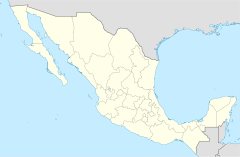San Blas Atempa facts for kids
Quick facts for kids
San Blas Atempa
|
|
|---|---|
|
Municipality and town
|
|
| Country | |
| State | Oaxaca |
| Area | |
| • Total | 148 km2 (57 sq mi) |
| Population
(2005)
|
|
| • Total | 16,899 |
| Time zone | UTC-6 (Central Standard Time) |
| • Summer (DST) | UTC-5 (Central Daylight Time) |
San Blas Atempa is a town and a special kind of area called a municipality in the state of Oaxaca, located in the southwestern part of Mexico. A municipality is like a local government area, similar to a county or district in other countries. It includes the main town and the smaller villages or rural areas around it.
As of 2005, about 16,899 people lived in the municipality of San Blas Atempa. The total area of the municipality is about 148 square kilometers (which is about 57 square miles).
Contents
About San Blas Atempa
San Blas Atempa is part of the Tehuantepec District. This district is located in the western part of the Istmo Region. The Istmo Region is a narrow strip of land that connects two larger landmasses. In this case, it connects the main part of Mexico with the Yucatán Peninsula.
What is a Municipality?
In Mexico, a municipality is a very important part of how the country is organized. It's the smallest unit of government. Each municipality has its own local government, led by a mayor. This government helps manage things like public services, local laws, and community projects.
The town of San Blas Atempa is the main center of its municipality. People often come to the town for markets, schools, and other services.
Geography and Climate
San Blas Atempa is in a region known for its warm climate. The weather here is often hot and humid, especially during the rainy season. This season usually brings a lot of rain, which helps the plants and crops grow.
The area around San Blas Atempa might have different types of land. It could include flat plains, rolling hills, or even some mountains. The specific geography affects what kind of plants and animals can live there.
Local Environment
The climate and geography of San Blas Atempa create a unique environment. The warm temperatures and rainfall support a variety of plant life. This also means many different animals call this place home.
Nature and Wildlife
The region where San Blas Atempa is located is rich in nature. You can find many interesting plants and animals here. The local environment is important for keeping these species safe.
Plants and Trees
Because of the warm climate, many tropical plants grow in the area. You might see different types of trees, flowers, and shrubs. Some common plants could include:
- Fruit trees like mango or papaya
- Palm trees
- Various types of cacti, especially in drier areas
- Colorful wildflowers
These plants provide food and shelter for local wildlife. They also help keep the air clean.
Animals You Might See
The forests and natural areas around San Blas Atempa are home to many animals. Some animals you might find include:
- Different kinds of birds, some with bright feathers
- Small mammals like rabbits or squirrels
- Reptiles such as lizards or snakes
- Various insects, including butterflies
Protecting these animals and their homes is important for the environment.
Life in San Blas Atempa
Life in San Blas Atempa often revolves around community and local traditions. Many people work in farming, growing crops that are suited to the local climate. Others might work in small businesses or services within the town.
Local Culture
Like many places in Oaxaca, San Blas Atempa likely has a rich cultural heritage. This can include:
- Traditional music and dances
- Local festivals and celebrations
- Unique crafts made by skilled artisans
- Delicious regional foods
These traditions are often passed down through generations. They help make the community special.
Community Activities
People in San Blas Atempa often gather for community events. These events can include:
- Religious festivals
- Local markets where people sell goods
- School events and sports activities
These gatherings help people connect and strengthen their community bonds.


